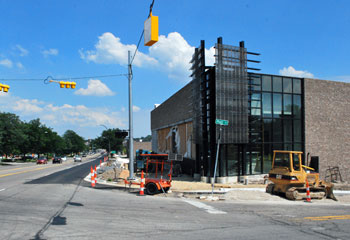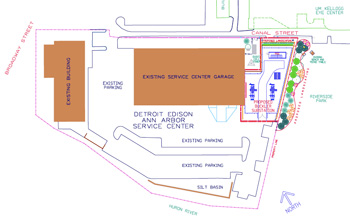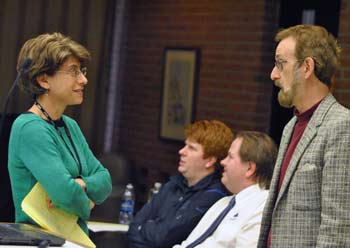Planning Group Gives Advice to Council, UM
Ann Arbor planning commission meeting (March 18, 2014): The planning commission has weighed in with advice on the use of two publicly owned sites: the city-owned Library Lane in downtown Ann Arbor, and the former Edwards Brothers property on South State that’s being bought by the University of Michigan.

From left: Ann Arbor planning commissioners Wendy Woods, Jeremy Peters and Paras Parekh. (Photos by the writer.)
One day after the Ann Arbor city council took action related to the Library Lane site, planning commissioners made recommendations to the council about how to develop that South Fifth Avenue property. The council’s action on March 17 included asking the city administrator to hire a brokerage service to sell development rights to the Library Lane surface, on top of an underground parking structure. The council also voted, after a long debate, to designate part of the surface for an urban public park.
On March 18, the commission’s advice focused on conditions for developing the site that would garner economic benefits to the city, such as a mixed-use development that generates foot traffic, with an entry plaza or open space and a design that “creates an iconic addition to the skyline.” The recommendations drew on material in several existing documents, including the Connecting William Street report that was completed by the Ann Arbor Downtown Development Authority about a year ago.
After the vote, Sabra Briere – who serves on both the planning commission and the city council – noted that many members of council don’t believe that the Connecting William Street project was successful in its public outreach. She also said that many councilmembers “do not believe that maximizing density, scale and mass of a building on that site is in the public interest.” Briere said she hadn’t raised these issues during the commission’s deliberations because she didn’t want anyone to feel that she was trying to tell the planning commission what to do.
In separate action on March 18, commissioners passed a resolution with recommendations on uses for the Edwards Brothers site on South State Street, which the University of Michigan is acquiring. The intent is to encourage representatives from the city and UM to discuss their mutual interests in that area – weighing the university’s need to expand its facilities against the city’s interest in strengthening its tax base. Issues include the possible private development of the section that fronts South State, impact on the park-and-ride lot in that area, and the extension of Oakbrook Drive from South State to South Main, through UM property. The city council is expected to consider the same resolution at its April 7 meeting.
Further south on the State Street corridor, at the intersection with Eisenhower Parkway, a proposal to renovate the Shell station, tear down the car wash, and add a drive-thru restaurant was recommended for approval by the commission on March 18. The existing convenience store and gas station would remain open during construction. The specific drive-thru restaurant to be located there is still being negotiated, according to the owner.
Some of the discussion on this project related to upcoming ordinance revisions that the commission will consider on April 1 regulating drive-thru restaurants.
Also recommended for approval on March 18 were an expansion to an office on Collingwood near West Stadium Boulevard, and an easement related to a new Belle Tire on West Ellsworth. [Full Story]










